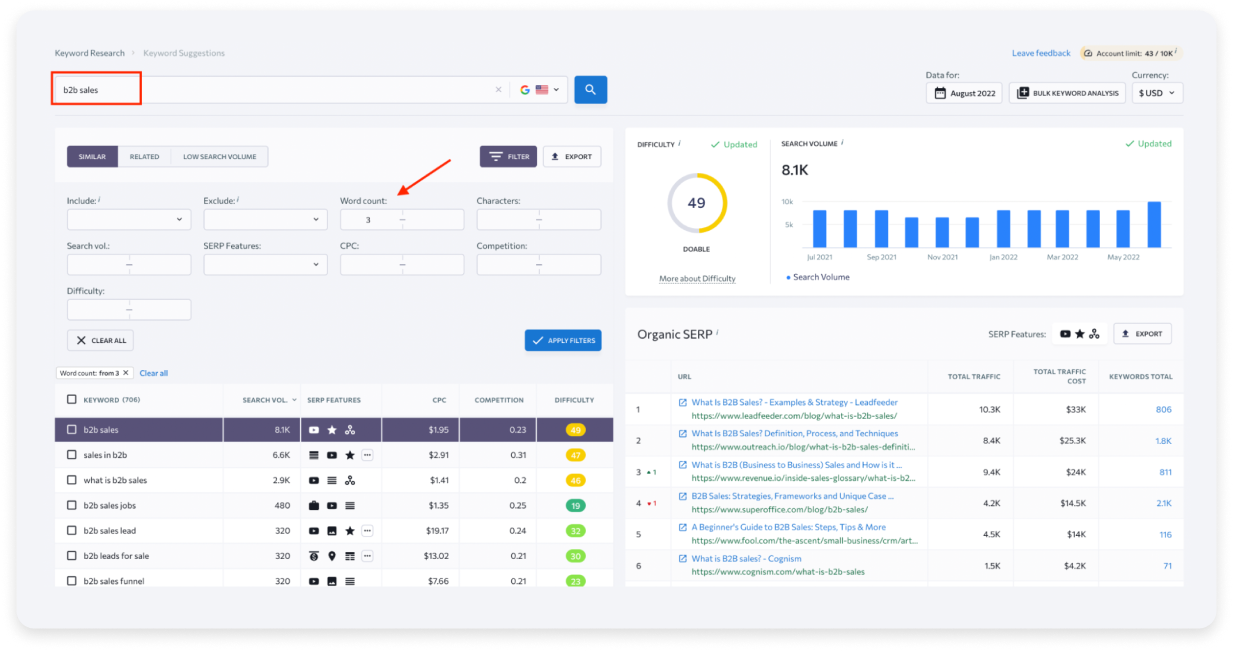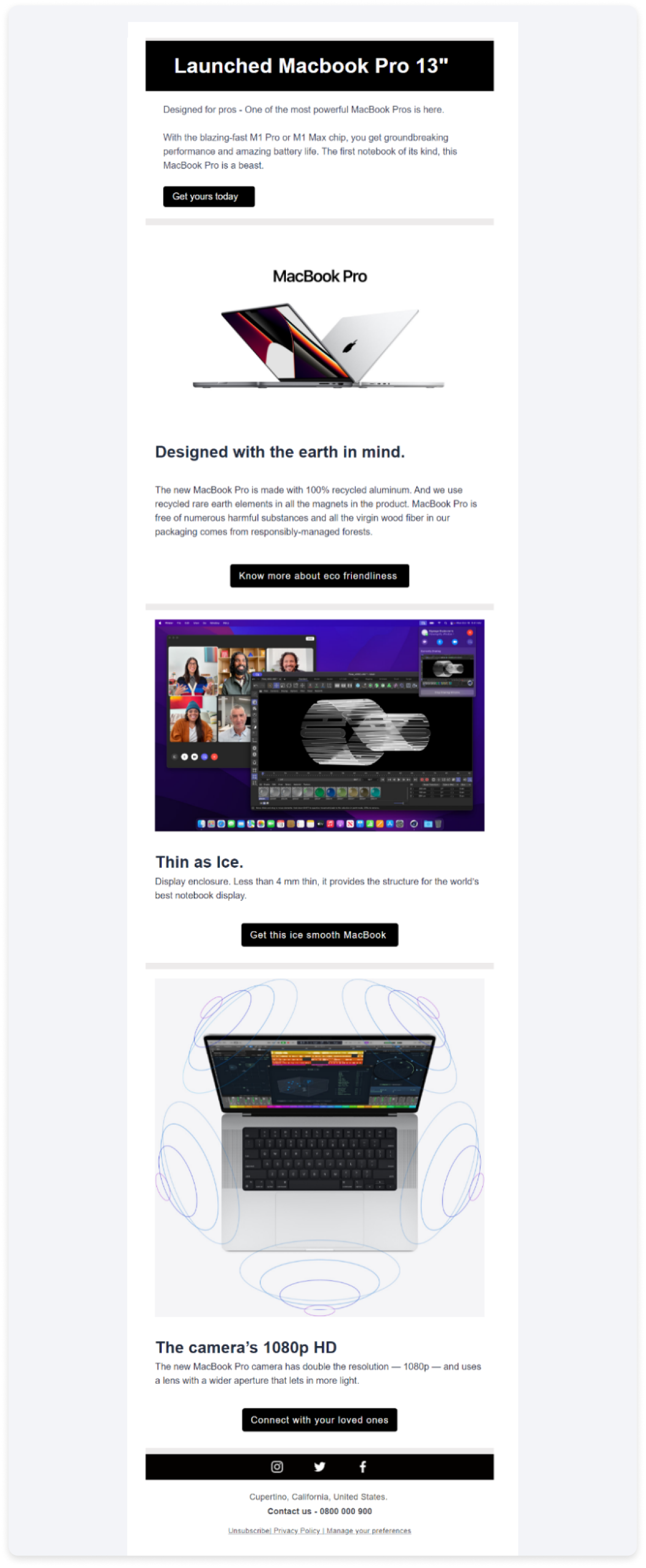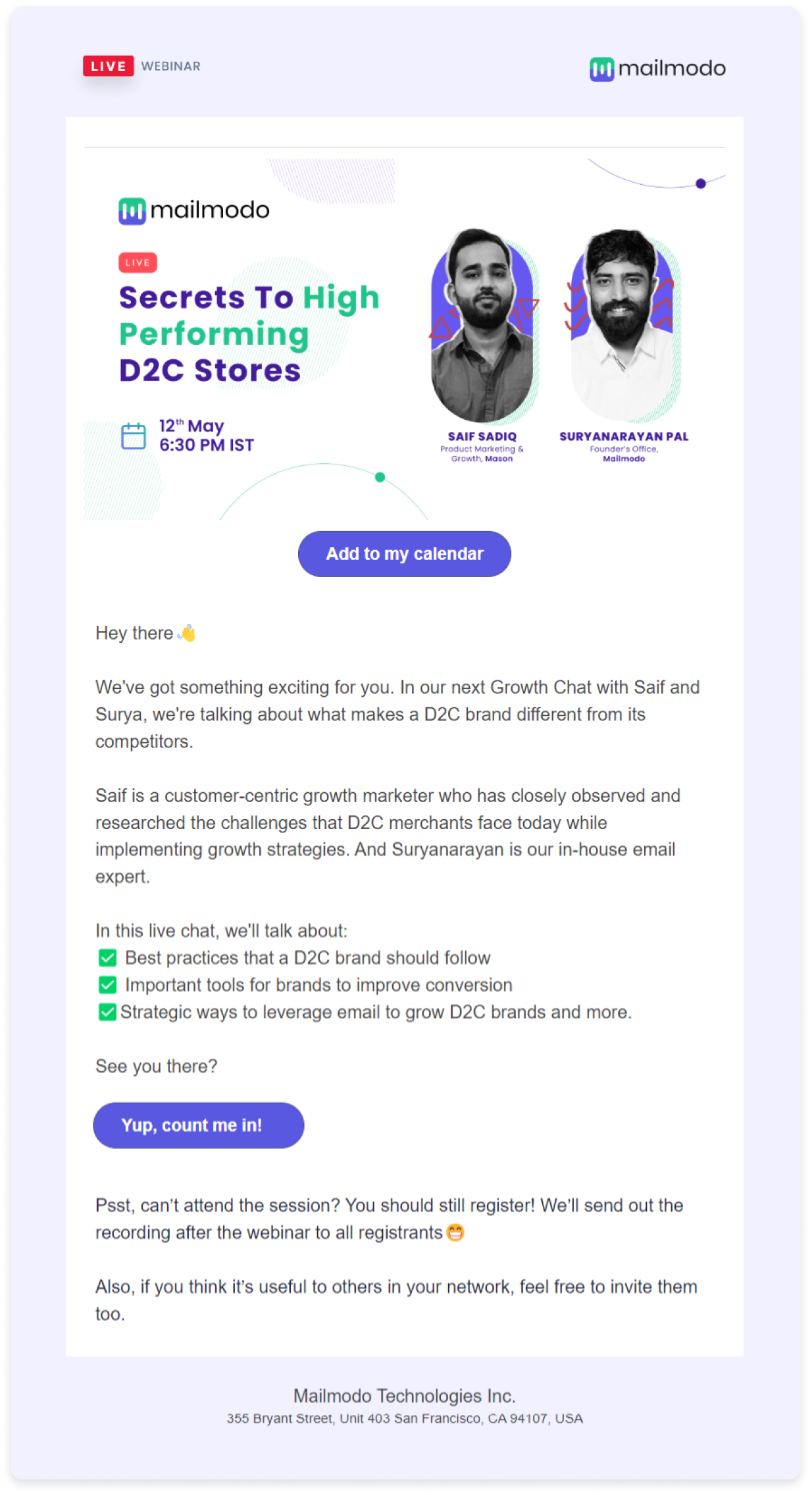People subscribe to your newsletter because they wish to know what's happening. Launching a new product, feature, or event is a perfect opportunity to communicate with your subscribers.
But most emails don't even get opened. Want to learn how to make your announcement emails effective? This guide will teach you how in under ten minutes.
Table of contents
What is an announcement email?
Run-of-the-mill marketing emails inform your customers about hot deals or urge them to make a purchase. When a company has a piece of news to share with its subscribers, they send an announcement email.
Since most announcement emails have something important to say to the customer, the statistics are on your side. A Hubspot survey of B2B professionals suggests that announcement emails have a higher click-through rate.
Types of announcement emails
There are multiple things a business can tell its newsletter subscribers. Here are some of the most common reasons to write an announcement email.
New business announcement emails are typically sent to a small number of people who have subscribed to the newsletter pre-launch. This letter lets them know the business is launched and ready to serve its customers.
New process launch announcement emails are also sent before the launch. These emails update subscribers on the development process and are crucial to creating buzz.
Website announcement emails share the news on either launching a new website or relocating to a new website.
Product launch announcement emails tell email subscribers that the company has launched a new type of good or service on its website.
New feature announcement emails inform subscribers that a new feature is coming out — typically a SaaS tool launching an update to their toolset.
New event announcement emails are used to let the newsletter subscribers know about a new webinar, meetup, or other events they can participate in.
Announcement emails to employees are sent internally within a company to inform employees about an important update in the company policy or to announce a company-wide event.
How to write an announcement email?
Emails are typically very short, not more than 200 words. But anyone who works with email marketing knows it takes much more time to create emails than read them. To simplify this process, here's a quick guide on how to write an announcement email.
1. Customer research
Sure, crafting the perfect email takes creativity. But it will fall short if you don't do your research first.
One of the ways you can research what your customers expect from your new products and features is by surveying your customers. Another method that doesn't take as many resources is keyword research.
You can explore keywords relevant to your business and current email campaign with marketing tools like the SE Ranking keyword generator. Pay special attention to keywords longer than three words. Long-form keywords often contain questions that people are searching for. Also, opt for keywords with high search volume, meaning higher interest in that phrase. This could give you an idea of what to put in your email.

It's not obligatory to run this analysis for every announcement email, but the data can benefit your email marketing.
2. Establish an emotional appeal
Before creating any announcement or marketing email, you must understand how the customer feels about it.
Do you want them to be in awe of your new makeup line? Do you want them excited about the new opportunities a launching feature brings? Or do you want them to be intrigued by the speakers at your latest webinar?
You need to choose the right angle in the email so that it doesn't just relay information but evokes an emotion in the reader. Craft your announcement template for the email with that in mind.
3. Craft a catchy subject line
The subject line is one of the first things a newsletter subscriber will see, and it's what they will judge the email by. It has to be catchy without being misleading.
That's one of the hardest things in creating any email, and there's always an element of subjectivity. You can make the process more unbiased, creating several subject lines and asking your team to pick the best ones. Later, you can run A/B tests with the best picks to see what works best.
💡 Related guide: How to Craft Email Subject Lines to Skyrocket Email Open Rates
4. Create content focused on value
When writing a copy for the email, you should include the information you want to announce. But this type of email doesn't have to be dry and informational.
Add a spin to your email and focus on the value the reader can get from it. Here's how we can change language from dry to value-based.
| Original message | Revised value-based message |
|---|---|
| We’re launching a new makeup line. | We’re bringing you new ways to be fabulous. |
| We’re launching a new automation feature. | Save time with our company. |
| This month's webinar is tomorrow. | Don’t miss out on industry insights tonight. |
| The company received an additional $5 mil in funding. | With a new round of funding, we’re ready to expand. |
Some emails need to be long, while some messages call for a couple of sentences and many visual elements. Even if yours is on the longer side, try to keep it under 200 words — people rarely have the time to read a long email. If you need to include more information, leave a link to it.
💡 Related guide: How to Write Persuasive Email Copies for Higher Conversions
5. Include visuals
Adding images to your email is the easiest way to tell your readers a lot while saying very little. Whether it's an image with an emotive appeal like a celebrity wearing your products, or a small infographic, a picture is always more communicative than a long email copy.
6. Add a call to action
In most cases, you send an email to get the user to perform an action. Make sure you're clear about what that action is and how they should proceed. Add a CTA button and make it stand out.
If your email is longer, add two CTAs, one right after the headline and another at the end of the email.
7 announcement email examples
The ultimate way to learn how to craft a perfect announcement email is by creating many of them and learning from your mistakes. But you shouldn't restrict yourself to only learning from mistakes and successes. Here are some announcement email samples you can use to learn the best practices.
1. Business process update announcement
Source: RellyGoodEmails
Subject line: We're changing our point of sale system this Tuesday!
The idea behind this announcement email example is brilliant. This company is changing its POS system and closing shop for a day. They're letting their customers know nothing is changing from their standpoint and answering some questions, thus making life easier for employees.
You might be wondering why it is essential to write an email if nothing is going to change. New customers will not spot the difference, but repeat customers will ask questions at the register. This email helps avoid that while showing some care for the customer base.
The takeaway:
Inform your loyal customers about the small things
It's okay to keep the email short and text-only for announcements that don't bring anything major to your customers
Using an FAQ section in an email is an interesting idea
2. Product launch announcement

Source: Mailmodo
This email announces the launch of the latest version of a product. It features a large image to catch attention and explains the new product briefly before placing a CTA.
Readers who don't know much about the product can scroll down the CTA button and find links to explainer articles. That's a great way to handle information that can't be realistically featured in the email.
The takeaway:
Including a visual in the first part of an email for goods is a great idea
Adding the CTA right after the essential information may increase the click-through rate
Leaving links to information that doesn't fit in an email is okay
Pro tip: You can also send emails about your product launch on the product hunt in your announcement email. You can customize and use our product hunt launch template for sending such announcements.
3. Pre-order product announcement
Source: ReallyGoodEmails
Subject line: Pre-order Pixel Buds Pro for immersive sound
Google Store makes three main points in this email:
A new product is going to launch soon
It's good
This store is the best place to pre-order it
It handles each in a short section of the launch announcement email. To explain the product's benefits in the email format features a brief description of the benefits along with a link to the website.
Since Google is a corporation, as to be expected, there's a rather lengthy legal disclosure covering marketing statements. Legal disclosure is not obligatory in most cases, but if you think your email may be construed as misleading due to marketing speak, it won't hurt to add one.
The takeaway:
Even concise copy can benefit from value-driven language
Shorten the email copy by providing links for further information
Two CTAs are not too many
Legal disclosure for marketing speak is a good idea
4. Upcoming event announcement

Source: Mailmodo
If the person who reads this email clicks the first CTA without scrolling down, all they're going to see is:
A headline that tells them clearly what the event is about
Who are the guests for the event
The date of the event
The CTA button
Honestly, that's more than enough to make a conversion. Additionally, you can go more in-depth about the event itself further down in the email. Personalize these emails and only send people announcements of events whose topics they are already interested in, as it often leads to increased conversions.
The takeaway:
Send people emails only if they have already shown interest in the related topic
Two CTAs are not too many
Personalizing larger event announcements, if possible, is a great idea
5. Company news announcement
Source: ReallyGoodEmails
Subject line: Anchor's analytics are now IAB certified
This email tells customers that the company has obtained an important certificate. Most people will understand that even without reading the email, the subject line conveys it clearly enough.
Those who open it will probably read a brief description of how the certification benefits them and not about how excited, and proud the company's CEO is. For those who want to learn more, there's a link to the detailed explanation on the website.
The takeaway:
For more formal announcements, make the subject line concise. It alone may be enough to communicate the information effectively.
Even formal events can be spun to show value for the customer
Complex topics can are best explained by making the email brief and leaving a link to a more detailed source of information
6. Project going live announcement
Source: ReallyGoodEmails
Subject line: Prepare for the Future of Warcraft, Username
"Company news for July" sounds okay. "Prepare for the future of our game" sounds epic. Blizzard went all in on the subject line of this email to make it click-worthy, plus it's a good wordplay since Future of Warcraft is the event's name.
The actual copy of the email tells the reader three dates of very important project announcements, and there is a link to learn more.
The takeaway:
Personalize your subject line if possible
Text links can be CTAs too
Important events can be communicated with a very brief email copy
7. Corporate news announcement
Source: ReallyGoodEmails
Subject line: Minor Figures is now carbon neutral!
This is a classic company policy update announcement email. Most of the information is conveyed through the subject line and the headline. The email explains what the update means for the customers in two sentences and invites them to learn more on the company blog.
The takeaway:
Communicate through the subject line
Make the email copy brief and to the point
Leave a link to learn more
Make announcements with Mailmodo
Announcements always matter to the companies making them. Often, they're about events they've been preparing for a long time or products that took hundreds of hours of work to develop. So, don't skip out on the shot to showcase them to your subscribers.
You can incorporate AMP widgets into your emails to leverage the power of interactive emails. For example, you can add a spin-the-wheel widget to your product launch emails to make them more engaging or include an interactive form within the email to get their thoughts about the new launch. Sign up and try it out for yourself.
What you should do next
Hey there, thanks for reading till the end. Here are 3 ways we can help you grow your business:
Talk to an email expert. Need someone to take your email marketing to the next level? Mailmodo’s experts are here for you. Schedule a 30-minute email consultation. Don’t worry; it’s on the house. Book a meet here.
Send emails that bring higher conversions. Mailmodo is an ESP that helps you to create and send app-like interactive emails with forms, carts, calendars, games, and other widgets for higher conversions. Get started for free.
Get smarter with our email resources. Explore all our knowledge here and learn about email marketing, strategies, best practices, growth hacks, case studies, templates, and more. Access guides here.


